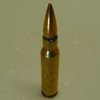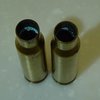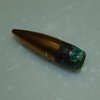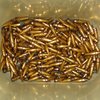You are using an out of date browser. It may not display this or other websites correctly.
You should upgrade or use an alternative browser.
You should upgrade or use an alternative browser.
Bad powder at such young age
- Thread starter Shimitup
- Start date
- Status
-
Not open for further replies.
Looks like finger prints. or a leather belt loop. I did that with my 357 and a leather belt with bullet loops.
Fingerprints on the bottom of the bullet? Belt loop contact with the sides of the primer?
tightgroup tiger
Member
Yea, somethings wrong there. I have ammo from the 1940s that still looks pristine. The powder looks fine, no rust, no discoloration, can't smell it from here though.
Powder looks like IMR 4350, but who knows what they used.
I don't know, but that's nasty.
Powder looks like IMR 4350, but who knows what they used.
I don't know, but that's nasty.
LiveLife
Member
Any ammo (factory or reloads) I want to store long-term gets vacuum packed. Finished rounds go into the Food Saver bag with a little dry rice and once sealed, they go into the ammo cans or 5 gallon buckets.
I have some 45ACP 230 gr FMJ ammo I reloaded in the 90s with Winchster 231 and Winchester LP primer and they still shoot fine with no sign of corrosion.
FWIW, I found tumbling brass in media treated with NuFinish polish doesn't tarnish as much. If corrosion of brass surface is cause, you could tumble loaded rounds in media treated with NuFinish before storing them long-term to treat the brass surface.
I have some 45ACP 230 gr FMJ ammo I reloaded in the 90s with Winchster 231 and Winchester LP primer and they still shoot fine with no sign of corrosion.
FWIW, I found tumbling brass in media treated with NuFinish polish doesn't tarnish as much. If corrosion of brass surface is cause, you could tumble loaded rounds in media treated with NuFinish before storing them long-term to treat the brass surface.
I sliced one, here's the inside. Notice the pits on the case wall and the grain of powder stuck to the case wall. No doubt the corrosion went through pin holes to the outside, the priming compound was mush.... gladly, I'd hate to pull the trigger and actually ignite powder in a case that looks like that.


Demi-human
maybe likes firearms a little bit…
Poor things. Can't even have a proper handloading after life. Cut down in their prime...
I wonder how some humans have any ammunition that long. I can't seem to keep any around.
Thankfully you were observant and spotted these.
If they could be cleaned and used soon, the bullets are still good, probably.
I wonder how some humans have any ammunition that long. I can't seem to keep any around.
Thankfully you were observant and spotted these.

If they could be cleaned and used soon, the bullets are still good, probably.
Ironicaintit
Member
maybe it was especially humid at the factory, the day they were assembled?
ive had some IMR4895 from the 70s go south on me, though it was stored in ideal conditions....and I had some FA 30-06 from the 30s that was still good.
( I did eventually pull them apart because corrosive primers)
ive had some IMR4895 from the 70s go south on me, though it was stored in ideal conditions....and I had some FA 30-06 from the 30s that was still good.
( I did eventually pull them apart because corrosive primers)
I've kind of wondered the same, or something in the process such as traces of swaging or drawing lubricant remaining in the case whose chemistry didn't agree with the powder. I've got some of my pet loads of IMR4350 under a Hornady 165 put together in '82 I think are still good. I may pull a few at this juncture however to double check.
Dudedog
Contributing Member
Ouch, bad news!
Just for fun since you have the box (and the lot number?) I would email Remmington and inquire if they had any other issue with that lot.
Who knows, maybe with some luck they might replace it. (doubtful but never can tell)
Just for fun since you have the box (and the lot number?) I would email Remmington and inquire if they had any other issue with that lot.
Who knows, maybe with some luck they might replace it. (doubtful but never can tell)
Last edited:
I sliced one, here's the inside. Notice the pits on the case wall and the grain of powder stuck to the case wall. No doubt the corrosion went through pin holes to the outside, the priming compound was mush.... gladly, I'd hate to pull the trigger and actually ignite powder in a case that looks like that.
View attachment 799901
Mind if I copy your photos and use them? I have been writing for years about gunpowder deterioration, and your pictures are good.
Twenty years is a long time for gunpowder. Ammunition manufacturer's provide ten year shelf lives, that is all they are going to promise. I recently fired these rounds, case neck cracks all around. I don't have the pictures, but I did have some 1989 rounds, that I reloaded, everyone one of them cracked their case necks.

It is up to us to educate our shooting buds about gunpowder lifetime. Industry is not going to do it. They don't stamp a "use by" date on ammunition, because, you might not buy old ammunition, or you might get fussy and want new ammunition. Horror's!
If I had known that gunpowder had a shelf life, I would not have stocked up on so much gun powder. I have tossed out 80% of all the surplus powders I purchased. I did not know the things were withdrawn from inventory because they were so old, the military was afraid to issue them to their troops, or to store the stuff, because it might auto com bust in bulk.
Just today, at the range, talked to a retired Navy Vietnam veteran. He personally witnessed a fellow sailor shooting an issue 1911, with old, issue ammunition, and the pistol his bud was shooting, blew up!
You did good by pulling bullets and inspecting. You just don't know what might have happened with the old stuff. Maybe just cracked cases, maybe a firearm in pieces:

Anyway I have been dumping mid nineties gunpowders I bought new
 . Complete jugs of Accurate Arms stick powders (AA4064) and Vihtavouri powders.
. Complete jugs of Accurate Arms stick powders (AA4064) and Vihtavouri powders.
There is unfortunately, a lot of denial about gunpowder having a shelf life. Optimists think they can drink liquor and smoke cigars, everyday, and live to a 100 , just like George Burns. He was an outlier, I have buried friends who died a lot younger, who smoked less. Maybe this will help convince you to keep on smoking:

Last edited:
Thank you Slamfire, and please do. BTW I've run across a fair number of folks on the forum having trouble pulling bullets. See the wire strippers in the first photo, they sure do snag the bullets. I just poke the cartridge up through the frame on the Rock Chucker, put a firm squeeze on the strippers, bump down the ram and out they pop.Mind if I copy your photos and use them?
Last edited:
sequins
Member
- Joined
- Oct 14, 2014
- Messages
- 1,478
I wonder if there is any data on which powder lasts the longest? I can't be the only one who wants enough ammo that I could shoot a thousand rounds a day and never run out, despite the evidence that even if I somehow amassed that ammo it would expire before I did...
ray15
Member
- Joined
- Apr 18, 2017
- Messages
- 946
Storage conditions play a huge role. Single base powders have better shelf-life potential than double base ones, but beyond that there aren't much in the way of rules. Anecdotally, you may hear reports of a given powder still usable after 50 years or more, and may find another report where the same powder degraded after 10 or 15 years.I wonder if there is any data on which powder lasts the longest? I can't be the only one who wants enough ammo that I could shoot a thousand rounds a day and never run out, despite the evidence that even if I somehow amassed that ammo it would expire before I did...
A few more photos, this time a 30-06 case charged with Reloader 7 also about 25 years old. I split the case with the corrosion spot a little offset in hopes of grinding toward the spot and finding the pin hole. I did! After a few touches to the belt sander it showed up, one more touch to show it up better and I obliterated it, Arrgh! I did mark the spot with arrows, the pits at each end of the channel are vaguely visible. The powder seems to get sticky when it becomes corrosive, it certainly has a reddish cast.






I wonder if there is any data on which powder lasts the longest? I can't be the only one who wants enough ammo that I could shoot a thousand rounds a day and never run out, despite the evidence that even if I somehow amassed that ammo it would expire before I did...
Generally, single based powders should last 45 years, double based 20 years. To caveat this, the powder has to be properly made, properly stored (cold temperatures and dry) and you have to be lucky. The lifetime of gunpowder is in fact so unpredictable that the Armed Forces pay people to inspect the stocks on a regular basis. If you want to become fabulously wealthy, just come up with some handy dandy algorithm that accurately predicts the life of smokeless propellants in inventory. Also use the same algorithm to predict human life spans, and the stock market, and when the next earth quake will hit.
Somethings, like the accurate prediction of smokeless powder lifetimes is beyond our capabilities at the moment. But, double based powders have nitroglycerine in them. Nitroglycerine attacks nitrocellulose, breaks it down, and that is why double based powders have less than half the expected shelf life of single base. So, I recommend buying single based powders.
But, there are plenty of examples of single based powders going bad at 20 years, so nothing is guaranteed. This was single based stick powder, some examples were autocombusting at eight years.

Take a look at the pictures in this thread, the powders were bought new in the 1990's and it is single based powder:
Has anyone else had Vihtavuori N140 corrode in loaded ammo?
http://www.falfiles.com/forums/showthread.php?p=3745264

If you see brown vapors coming out of your powder, you have a problem.
Ball powder degredation
https://www.thehighroad.org/index.php?threads/ball-powder-degredation.830523/#post-10721822
I can tell you 100% without a doubt that the brown coloration in the gas is attributed to the presence of Nitrogen Dioxide. Other oxides of nitrogen that would form are colorless. Gun powder does break down over time into NOx as it degrades and oxidizes. You are also correct that Nitrogen Dioxide reacts with latent humidity to form nitric acid. Nitric acid vapor is colorless or a hazy white at very high concentration. This is not a complete conversion reaction. Nitrogen Dioxide and nitric acid will be in equilibrium with each other in the closed volume of say a loaded case. I don't recall what the equilibrium concentrations are off the top of my head but I believe it to favor Nitrogen Dioxide, hence the strong brown color.
Over time it is reasonable to assume that this reaction could be responsible for degradation of brass. Brasses have terrible chemical compatibility with nitrating acids. Evidence that they have been attacked would be a green or blue discoloration on the interior of a case or surrounding a crack
Heat is used to age gun powder, heat ages it real quick:
And, as it gets old, combustion pressures rise.

There is not one good thing about old gunpowder, including the fact at some point in its life, it will auto combust in bulk containers. And yet, the popular press totally ignores this.Makes you wonder, just whose side are they on?
Last edited:
ray15
Member
- Joined
- Apr 18, 2017
- Messages
- 946
Unfortunately I fear were they to 'get on our side' it would result in additional regulations on the sale and storage of smokeless powder that might well impact reloaders negatively. Perhaps it's best they continue their slumber.There is not one good thing about old gunpowder, including the fact at some point in its life, it will auto combust in bulk containers. And yet, the popular press totally ignores this.Makes you wonder, just whose side are they on?
Unfortunately I fear were they to 'get on our side' it would result in additional regulations on the sale and storage of smokeless powder that might well impact reloaders negatively. Perhaps it's best they continue their slumber.
It took just a second to find this:
Low Explosives
Low explosives deflagrate producing a large volume of heated gas. Low explosives, such as black powder, most display fireworks, safety fuse, igniters, igniter cord, fuse lighters, etc., must be stored in:
- Type-1, -2, or -4 permanent, portable or mobile indoor/outdoor magazines.
18 U.S.C. 842(j): STORAGE OF EXPLOSIVES 27 CFR 55.208(b)(1), 55.210(b)(1), and 55.211(b)(1): INDOOR STORAGE OF EXPLOSIVES IN A RESIDENCE OR DWELLING
ATF will approve variances to store explosives in a residence or dwelling only upon certain conditions including, but not limited to , receipt of a certification of compliance with State and local law, and documentation that local fire safety officials have received a copy of the certification
Someone can research this further, as whether explosives as means gunpowder, call your local BATF to find out, but even if the Feds do not have a regulation on gunpowder in the home, it would be folly to believe that someone in a local Governmental regulator body has not thought about this.
Smokeless propellants storage and quantity may be controlled by local fire codes. If someone has access to NFPA 400, you can tell us if that applies.
https://www.nfpa.org/codes-and-stan...s-and-standards?mode=code&code=495&DocNum=495
Do not assume that because you are ignorant that everyone else is ignorant.
Last edited:
Toprudder
Member
I believe "Black powder", is classified as an explosive. "Smokeless powder" is classified as a propellant. But I guess it depends on who you are talking to. I have seen both listed as "low explosive" before.
Last edited:
ray15
Member
- Joined
- Apr 18, 2017
- Messages
- 946
Who exactly is that pearl of wisdom aimed at?Do not assume that because you are ignorant that everyone is ignorant.
Who exactly is that pearl of wisdom aimed at?
Just a general comment. Maybe someone can craft a better, more concise statement that ignorance (lack of knowledge) is not a protection against anything. Someone out there knows, and knew before you knew, and probably knows more about the topic then you will ever know. That sort of thing.
And let me add, I was totally ignorant on this topic till I ran into a Naval Insensitive Munitions expert. I learned enough to self educate. I found a host of literature, studies, conferences. Just Google the term "Insensitive Munitions" and follow the links and terms where they will lead you.
And I also learned about Agnotology. Which is the study of culturally induced ignorance. A very good question from Robert M. Proctor's book on Agnotology is: why don't you know, what you don't know?
Last edited:
454PB
Member
I've been handloading for 48 years now. I have seen old military ammo that looked like many of these pictures, but never seen it in any commercial or handloads that I assembled. In that 48 years, I've had three cans of powder degrade, all were IMR powders, two were opened containers that were given to me (so I can't say how they were stored), and one was a sealed can of IMR 4064 that I bought and stored for about 15 years. Right now I have several cans of ball powder that I bought in the mid 70's that appear to be like new. All my powder is stored in a well insulated loading room that is not temperature controlled. Even with Montana's temperature extremes, I've never seen a temperature below 30 degrees in the winter, or above 80 degrees in the summer in that room. In addition, Montana has very low humidity.
- Status
-
Not open for further replies.
Similar threads
- Replies
- 19
- Views
- 2K
- Replies
- 6
- Views
- 339






